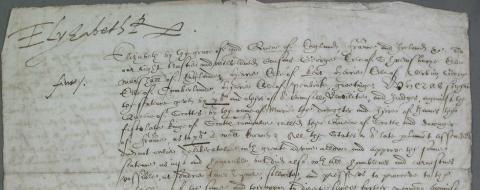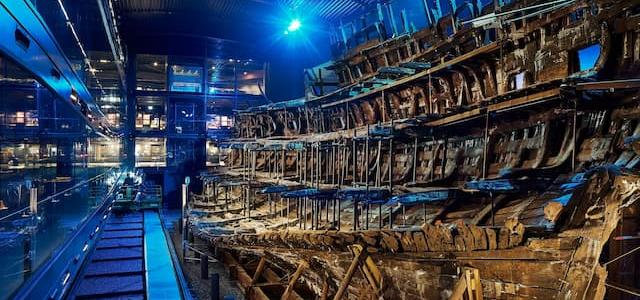
Mary Queen of Scot's execution warrant saved for the nation
Lambeth Palace Library – the historic library and record office of the Archbishop of Canterbury, founded in 1610 – has acquired a document intimately involved with one of Britain’s most dramatic historical events.

This was after benefactors of the Library donated funds to keep a copy of the warrant for the execution of Mary Queen of Scots in the U.K.
In November 2007, Minister of State for Culture Margaret Hodge placed a temporary export bar on the document, following a recommendation by the Reviewing Committee on the Export of Works of Art and Objects of Cultural Interest, administered by the Museums, Libraries and Archives Council (MLA). The Committee recommended that the manuscript is so closely connected with our history and national life that its departure would be a misfortune, and awarded a starred rating to the document. This effectively provided a last chance to raise the money to keep the document in this country.
Lambeth Palace Library took up this challenge and has purchased the document for £72,485.50, thanks to the combined generosity of the Friends of the National Libraries, the Friends and Trustees of Lambeth Palace Library, the MLA/V&A Purchase Grant Fund, and the National Heritage Memorial Fund. All of the funding has come from bodies concerned with heritage, without depleting resources available for the Church’s mission.
Dr. Richard Palmer, the Lambeth Librarian, said: “The Library is delighted to have played its part in saving this document for the nation. The warrant is now reunited with the papers with which it belongs and accessible for the benefit of all”.
Mary Queen of Scots, with her claims to the crowns of England and Scotland, her beauty and charisma, her marriages and love affairs, and years of imprisonment, has long been a heroine in the popular imagination. Her execution on 8th February 1587, after great agonizing by her cousin Elizabeth I, is one of the best known events in British history.
Robert Beale, principal clerk to the Privy Council of the time, was responsible for bearing the warrant to the commissioners who were instructed to ‘repair to our Castell of Fotheringhaye where the said queene of Scottes is in custodie and cause by your commaundement execution to be don uppon her person’. Elizabeth I signed the warrant, but claimed afterwards that she had given no instruction for its enactment. The original warrant disappeared in the recriminations which followed. This copy, which includes Beale’s annotation, was delivered by him to Henry Grey, 6th Earl of Kent, one of the two commissioners tasked with organising the execution. It was accompanied by a covering letter to the Earl from the Privy Council which has long been part of the collections of Lambeth Palace Library. These two documents, which played a central role in the drama, are now reunited in the Library’s care.
Lambeth Palace Library is one of England’s oldest public libraries. Its entire collections are designated by the Museums, Libraries and Archives Council as outstanding in national and international importance. The Library holds significant archives relating to Mary Queen of Scots, including papers not only of Henry Grey, 6th Earl of Kent, but of George Talbot, 6th Earl of Shrewsbury, who was for many years custodian of the Queen in her captivity and the second commissioner responsible for her execution. The Library also holds the sermon which was to have been preached at the execution, but which Mary declined to hear. An illustrated subject guide to these sources on the Queen is accessible on the Library’s website, at www.lambethpalacelibrary.org.
Lambeth Palace Library is freely open to the public for research. The copy of the warrant will now be available for research and exhibition, including loans for exhibitions on both sides of the Scottish border.
Notes to editors
Further information on the Library is accessible on its website: www.lambethpalacelibrary.org.
The Reviewing Committee on the Export of Works of Art and Objects of Cultural Interest
The Reviewing Committee on the Export of Works of Art and Objects of Cultural Interest is an independent body, serviced by the Museums, Libraries and Archives Council, which advises the Secretary of State for Culture, Media and Sport on whether a cultural object, intended for export, is of national importance under specific criteria.
The Friends of the National Libraries
The Friends of the National Libraries, a voluntary organisation consisting mainly of individual members, was founded in 1931. Its purpose is to help libraries in the UK acquire books, manuscripts and archives, in particular those which might otherwise leave this country.
The MLA/V&A Purchase Grant Fund
The MLA/V&A Purchase Grant Fund is a government fund, established at the Victoria & Albert Museum (V&A) in 1881 as part of its nationwide work. 2006 marked the Fund’s 125th anniversary. The annual grants budget, currently £1,000,000, is provided by the Museums, Libraries and Archives Council (MLA). The Fund supports the acquisition of objects relating to the arts, literature and history by regional museums, record offices and specialist libraries in England and Wales. Each year it considers some 300 applications and in 2006-07 awarded grants to 115 organisations, enabling acquisitions of over £4 million to go ahead.
About the warrant
This is a two-page folio paper document, dated 1st February 1586/7, containing the text of the warrant for the execution of Mary Queen of Scots, annotated by Robert Beale, principal clerk to the Privy Council of Elizabeth I, and retained by Henry Grey, 6th Earl of Kent, one of the principal commissioners for the trial and execution. It is in good condition, apart from some predictable signs of wear and soiling.
The document is an integral part of a small archive concerning the execution of Mary Queen of Scots, last sold at Sotheby’s on 16th December 1996, lots 40-43. They derived originally from the papers of the Earl of Kent, subsequently became part of the collection of the celebrated antiquary and jurist John Selden (1584-1654), descended in the family of his executor, Matthew Hale, until the 1930s, were acquired by the collector, James Fairhurst, and sold at Sotheby’s, 4th June 1946, as part of lot 385, and acquired by another collector, John Burton, before being sold again at Sotheby’s in 1996. The present document was lot 42 in that sale. It was an enclosure in the Privy Council letter to the Earl of Kent, ordering the enactment of the execution, lot 42 in the same sale, which was acquired by Lambeth Palace Library.
No original of this warrant, sealed with the great seal, survives. It is likely that it was deliberately destroyed in the aftermath of the execution, when the Queen reacted violently against all those involved. In its absence the copies of Robert Beale are the primary evidence of this outstanding historical text. The present document is in a professional secretary hand, with marks and annotations in black ink in Beale’s distinctive hand. These consist of the heading ‘Elizabeth R’ at the head of the warrant and the large flourished capital ‘Q’ twice in the margin. The text also has several heavy underlinings of passages whose purport is to emphasize the commissioners’ responsibility for executing the warrant.
Further information
Ben Wilson, Church of England Communications Officer
Phone: 020 7898 1326.
John Harrison, MLA Head of Media Relations:
Phone: 020 7273 1402 Email: john.harrison@mla.gov.uk
Pictures of this item are available, contact: richard.palmer@c-of-e.org.uk
Dervish Mertcan or Alex Gaskell NHMF press officers.
Phone: 020 7591 6102 / 6032, mobile: 07973 613 820

